
|
Appearing in the evening sky. Now it is very bright as 8.2 mag (May 25, Mike Olason). It is brighter than originally predicted by 3 mag. The condition is very bad in this apparition. It is observable only in the extremely low sky from mid May to mid July in the Northern Hemisphere, or from early June to early August in the Southern Hemisphere.
Date(TT) R.A. (2000) Decl. Delta r Elong. m1 Best Time(A, h)
May 28 6 20.01 24 53.5 1.570 0.829 28 9.1 20:48 (117, 5)
June 4 7 2.75 24 34.7 1.629 0.925 31 10.2 20:54 (116, 6)
|
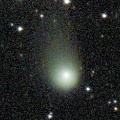
|
Now it is bright as 9.9 mag (May 23, Osamu Miyazaki). The brightness evolution is slower than originally expected. It is expected to be observable at 7.5-8 mag for a long time from 2022 to 2023. In the Northern Hemisphere, it stays observable in good condition until autumn. However, it is not observable at the high light from autumn to 2023 summer. In the Southern Hemisphere, it stays observable in good condition for a long time.
Date(TT) R.A. (2000) Decl. Delta r Elong. m1 Best Time(A, h)
May 28 18 27.53 10 2.1 2.263 3.068 135 9.4 2:08 ( 0, 65)
June 4 18 17.44 9 1.4 2.144 3.005 141 9.2 1:30 ( 0, 64)
|
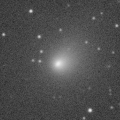
|
Now it is very bright as 9.8 mag (May 6, Marco Goiato). It stays bright as 9-10 mag from spring to summer. In the Southen Hemisphere, it stays observable in good condition for a long time after this. In the Northern Hemisphere, it is not observable until November when it fades down to 14 mag.
Date(TT) R.A. (2000) Decl. Delta r Elong. m1 Best Time(A, h)
May 28 23 30.63 -74 40.0 1.221 1.788 105 9.3 3:06 (345,-26)
June 4 2 15.87 -81 16.8 1.219 1.780 105 9.3 3:02 (349,-35)
|

|
Now it is 10.0 mag (May 24, Osamu Miyazaki). It will be getting lower after this. In the Northern Hemisphere, it will be unobservable soon. In the Southern Hemisphere, it stays observable until July.
Date(TT) R.A. (2000) Decl. Delta r Elong. m1 Best Time(A, h)
May 28 7 28.59 9 29.1 4.384 3.770 47 10.8 20:48 ( 95, 9)
June 4 7 35.62 8 35.3 4.473 3.792 42 10.9 20:54 ( 98, 3)
|
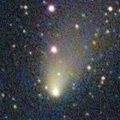
|
Now it is bright as 12.0 mag (May 18, Michael Jager). It is expected to brighten up to 9-10 mag in summer. In the Northern Hemisphere, it stays observable in good condition until June when it brightens up to 10 mag. But it is not observable after the high light. In the Souther Hemisphere, it is not observable until October.
Date(TT) R.A. (2000) Decl. Delta r Elong. m1 Best Time(A, h)
May 28 6 0.91 55 50.5 2.118 1.482 39 11.4 20:48 (145, 20)
June 4 6 38.47 53 14.8 2.074 1.411 37 11.1 20:54 (142, 19)
|

|
Now it is 11.1 mag (May 21, Thomas Lehmann). In the Northern Hemisphere, it stays extremely low until spring. In the Southern Hemisphere, it stays observable at 11 mag until June.
Date(TT) R.A. (2000) Decl. Delta r Elong. m1 Best Time(A, h)
May 28 23 59.64 -2 5.9 1.822 1.709 67 11.5 3:06 (285, 17)
June 4 0 13.92 -0 53.9 1.795 1.738 70 11.6 3:02 (285, 19)
|

|
Now it is bright as 11.7 mag (May 24, Osamu Miyazaki). It stays observable at 11-12 mag until July.
Date(TT) R.A. (2000) Decl. Delta r Elong. m1 Best Time(A, h)
May 28 11 47.24 -9 20.4 3.728 4.244 114 11.7 20:48 ( 28, 41)
June 4 11 49.62 -8 14.4 3.824 4.243 107 11.7 20:54 ( 38, 39)
|
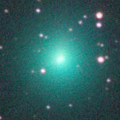
|
It brightened very rapidly up to 9.3 mag in March (Mar. 24, Michael Jager). In the Southern Hemisphere, it is appearing in the morning sky. It stays observable in good condition after this. In the Northern Hemisphere, it will never be observable again.
Date(TT) R.A. (2000) Decl. Delta r Elong. m1 Best Time(A, h)
May 28 2 44.20 -0 9.9 2.066 1.313 31 11.9 3:06 (259,-16)
June 4 2 55.77 -3 42.4 2.046 1.388 37 12.4 3:02 (263,-15)
|

|
Now it is 13.2 mag (May 4, Thomas Lehmann). It stays 12-13 mag for a while. It is observable in excellent condition in the Southern Hemisphere. It locates somewhat low in the Northern Hemisphere.
Date(TT) R.A. (2000) Decl. Delta r Elong. m1 Best Time(A, h)
May 28 22 31.69 -20 6.7 1.348 1.745 94 12.8 3:06 (314, 20)
June 4 22 42.71 -20 6.2 1.317 1.776 98 12.9 3:02 (316, 21)
|

|
Now it is 13.7 mag (May 14, Giuseppe Pappa). It will brighten up to 12.5 mag in summer. In the Southern Hemisphere, it stays observable in excellent condition for a long time. In the Northern Hemisphere, it is not observable until August.
Date(TT) R.A. (2000) Decl. Delta r Elong. m1 Best Time(A, h)
May 28 22 15.80 -59 47.9 2.683 3.156 108 13.1 3:06 (340,-11)
June 4 21 58.58 -61 14.5 2.563 3.133 115 13.0 3:02 (345,-10)
|
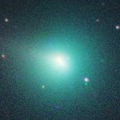
|
It brightened up to 8.8 mag from winter to early spring (Jan. 31, Chris Wyatt). Now it is fading. It has already faded down to 13.4 mag (May 14, ATLAS-MLO, Mauna Loa). It locates extremely low in the Southern Hemisphere. It will be unobservable in August in the Northern Hemisphere.
Date(TT) R.A. (2000) Decl. Delta r Elong. m1 Best Time(A, h)
May 28 7 55.67 42 11.7 2.333 1.848 49 13.2 20:48 (123, 30)
June 4 8 18.88 41 25.1 2.421 1.899 48 13.5 20:54 (123, 28)
|

|
Now it is 14.2 mag (May 4, Thomas Lehmann). It will brighten up to 13 mag in summer.
Date(TT) R.A. (2000) Decl. Delta r Elong. m1 Best Time(A, h)
May 28 19 8.72 -29 22.8 2.193 3.046 140 13.4 2:49 ( 0, 26)
June 4 19 6.44 -29 52.4 2.137 3.044 147 13.4 2:19 ( 0, 25)
|

|
Now it is 14.9 mag (May 6, Chris Wyatt). It was expected to brighten up to 13 mag in spring. But actually, it is fainter than this ephemeris recently. In the Southern Hemisphere, it stays observable in good condition for a long time. In the Northern Hemisphere, it is not observable until autumn.
Date(TT) R.A. (2000) Decl. Delta r Elong. m1 Best Time(A, h)
May 28 6 29.85 -43 57.6 3.301 3.139 71 13.6 20:48 ( 55,-30)
June 4 6 31.27 -42 37.4 3.346 3.135 69 13.6 20:54 ( 59,-35)
|
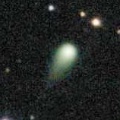
|
Now it is 13.4 mag (May 18, Masayoshi Yoshimi). It is expected to brighten up to 10 mag in 2023. In the Northern Hemisphere, it stays observable in good condition until 2023 autumn. In the Southern Hemipshere, it stays unobservable until 2023 summer.
Date(TT) R.A. (2000) Decl. Delta r Elong. m1 Best Time(A, h)
May 28 9 59.25 58 46.5 4.553 4.303 69 13.6 20:48 (142, 51)
June 4 9 55.59 58 3.8 4.583 4.246 64 13.6 20:54 (140, 46)
|
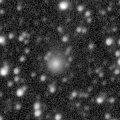
|
Now it is 14.3 mag (May 6, Chris Wyatt). It is expected to brighten up to 11 mag in 2023. In the Northern Hemisphere, it stays observable in good condition until November. But it becomes unobservable after that. In the Southern Hemisphere, it stays observable in good condition after this.
Date(TT) R.A. (2000) Decl. Delta r Elong. m1 Best Time(A, h)
May 28 18 43.01 18 37.0 3.807 4.485 126 13.7 2:23 ( 0, 74)
June 4 18 36.80 18 13.1 3.704 4.440 131 13.6 1:49 ( 0, 73)
|
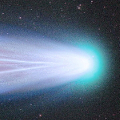
|
It brightened up to 3 mag from mid December to late December. Now it is fading. It has already faded down to 12.2 mag (Apr. 2, Thomas Lehmann). It is observable in good condition in the Southern Hemisphere. It is getting observable again also in the Northern Hemisphere.
Date(TT) R.A. (2000) Decl. Delta r Elong. m1 Best Time(A, h)
May 28 18 35.21 -38 46.5 1.655 2.558 145 13.7 2:16 ( 0, 16)
June 4 18 7.34 -37 55.3 1.688 2.650 156 13.9 1:21 ( 0, 17)
|

|
Now it is 13.8 mag (May 4, Hirohisa Sato). It is expected to brighten up to 12 mag in 2023. In the Northern Hemisphere, it stays observable in good condition for a long time. In the Southern Hemisphere, it locates extremely low in 2022, but it will be observable in good condition in 2023.
Date(TT) R.A. (2000) Decl. Delta r Elong. m1 Best Time(A, h)
May 28 14 33.26 42 27.4 4.050 4.524 111 13.7 22:08 (180, 83)
June 4 14 21.13 41 30.8 4.074 4.489 107 13.7 21:29 (180, 84)
|
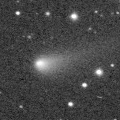
|
Now it is 13.8 mag (May 6, Chris Wyatt). It is observable at 13 mag in good condition until early summer.
Date(TT) R.A. (2000) Decl. Delta r Elong. m1 Best Time(A, h)
May 28 10 10.07 12 59.3 2.099 2.225 83 13.8 20:48 ( 73, 44)
June 4 10 19.77 11 52.4 2.168 2.218 79 13.8 20:54 ( 76, 38)
|
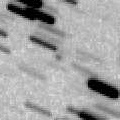
|
It is expected to brighten up to 13.5 mag in early summer. In the Southern Hemisphere, it is appearing in the morning sky. It stays observable in good condition after this. In the Northern Hemisphere, it is not observable at all.
Date(TT) R.A. (2000) Decl. Delta r Elong. m1 Best Time(A, h)
May 28 3 8.35 -23 15.4 1.693 1.259 47 14.1 3:06 (277,-33)
June 4 3 28.03 -27 32.3 1.552 1.249 53 13.9 3:02 (282,-34)
|

|
Now it is not observable. It will be observable again in August.
Date(TT) R.A. (2000) Decl. Delta r Elong. m1 Best Time(A, h)
May 28 5 20.57 29 12.2 6.956 5.989 16 14.0 20:48 (129, -3)
June 4 5 26.79 29 13.4 6.983 5.991 11 14.1 20:54 (134, -7)
|
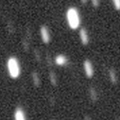
|
Now it is 14.9 mag (May 18, ATLAS-HKO, Haleakala). It will approach to Earth down to 0.29 a.u. in 2023 February, and it is expected to brighten up to 5 mag. In the Northern Hemisphere, it stays observable in excellent condition. In the Southern Hemisphere, it becomes unobservable from late September to early February.
Date(TT) R.A. (2000) Decl. Delta r Elong. m1 Best Time(A, h)
May 28 19 58.90 21 9.4 2.861 3.364 111 14.6 3:06 (331, 74)
June 4 19 51.17 23 24.5 2.716 3.288 115 14.3 3:02 (358, 78)
|
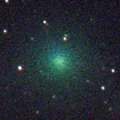
|
It was expected to brighten up to 4 mag, but it faded rapidly around the perihelion passage. Now it is 12.9 mag (May 18, Michael Jager). It stays observable in good condition after this while the comet will be fading. In the Southern Hemisphere, it is not observable until August.
Date(TT) R.A. (2000) Decl. Delta r Elong. m1 Best Time(A, h)
May 28 9 11.80 81 36.1 0.803 1.011 66 14.6 20:48 (171, 40)
June 4 12 23.28 78 13.0 0.920 1.151 72 15.6 20:54 (174, 47)
|
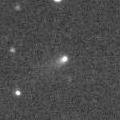
|
Now it is 15.3 mag (May 18, Michael Jager). It is expected to brighten up to 11-12 mag from summer to autumn. It stays observable in good condition in the Southern Hemisphere. In the Northern Hemisphere, it becomes extremely low from August to September.
Date(TT) R.A. (2000) Decl. Delta r Elong. m1 Best Time(A, h)
May 28 10 1.66 24 7.1 1.398 1.545 77 15.1 20:48 ( 88, 48)
June 4 10 11.11 22 24.6 1.396 1.481 73 14.8 20:54 ( 89, 42)
|

|
Now it is 15.7 mag (May 1, Thomas Lehmann). It stays at 15-16 mag for a long time. In the Southern Hemisphere, it stays observable in excellent condition for a long time. In the Northern Hemiphere, it locates extremely low in spring.
Date(TT) R.A. (2000) Decl. Delta r Elong. m1 Best Time(A, h)
May 28 15 52.02 -50 24.9 4.331 5.237 150 14.9 23:28 ( 0, 4)
June 4 15 39.14 -50 44.2 4.360 5.253 148 14.9 22:47 ( 0, 4)
|

|
Now it is 17.6 mag (May 10, W. Hasubick). It will brighten rapidly, and it will brighten up to 12 mag from June to July. It stays observable in the morning sky until June.
Date(TT) R.A. (2000) Decl. Delta r Elong. m1 Best Time(A, h)
May 28 0 28.20 10 59.3 1.074 0.979 55 15.8 3:06 (269, 18)
June 4 1 13.37 13 59.3 1.051 0.891 51 14.9 3:02 (264, 16)
|

|
It approached to Sun down to 0.14 a.u. on May 15. But it was not observable around that time. In the Northern Hemisphere, it will appear in the morning sky at 16 mag in June. It is hardly observable in the Southern Hemisphere.
Date(TT) R.A. (2000) Decl. Delta r Elong. m1 Best Time(A, h)
May 28 2 38.71 24 25.4 1.178 0.466 23 15.1 3:06 (240, 0)
June 4 2 46.04 26 59.3 1.323 0.635 27 15.7 3:02 (240, 5)
|

|
Now it is not observable. It will appear in the morning sky in September in the Northern Hemisphere, or in November in the Southern Hemisphere. It will brighten up to 11.5 mag in winter
Date(TT) R.A. (2000) Decl. Delta r Elong. m1 Best Time(A, h)
May 28 5 26.56 21 30.3 3.393 2.435 15 15.5 20:48 (123, -7)
June 4 5 40.26 21 43.3 3.374 2.394 12 15.4 20:54 (126,-10)
|

|
It brightened up to 12.3 mag from spring to summer in 2021 (June 15, 2021, Marco Goiato). Now it is fading. It has already faded down to 15.2 mag (May 21, Thomas Lehmann).
Date(TT) R.A. (2000) Decl. Delta r Elong. m1 Best Time(A, h)
May 28 12 13.99 31 53.6 4.662 4.956 100 15.5 20:48 ( 79, 78)
June 4 12 9.50 31 51.4 4.818 4.999 94 15.7 20:54 ( 88, 70)
|
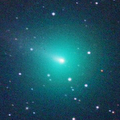
|
It brightened very rapidly up to 9.2 mag in winter (Jan. 31, Chris Wyatt). Now it is fading. It has already faded down to 14.7 mag (May 3, Chris Wyatt). It will be fainter than 18 mag in July.
Date(TT) R.A. (2000) Decl. Delta r Elong. m1 Best Time(A, h)
May 28 9 34.35 10 57.1 1.947 1.965 75 15.6 20:48 ( 77, 35)
June 4 9 48.99 10 0.9 2.073 2.024 72 16.0 20:54 ( 80, 31)
|
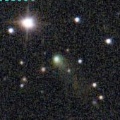
|
Now it is 15.9 mag (May 15, Thomas Lehmann). It stays observable at 16 mag from 2021 to 2022.
Date(TT) R.A. (2000) Decl. Delta r Elong. m1 Best Time(A, h)
May 28 15 48.03 41 47.2 4.533 5.066 116 16.0 23:23 (180, 83)
June 4 15 43.10 42 24.3 4.595 5.087 113 16.0 22:51 (180, 83)
|

|
Now it is 17.2 mag (May 4, Ken-ichi Kadota). It will brighten up to 16 mag from spring to summer. It locates somewhat low in the Northern Hemisphere.
Date(TT) R.A. (2000) Decl. Delta r Elong. m1 Best Time(A, h)
May 28 19 59.53 -23 9.2 2.442 3.179 129 16.3 3:06 (351, 31)
June 4 19 59.01 -23 33.9 2.380 3.188 135 16.2 3:02 (357, 31)
|

|
Now it is 17.9 mag (May 11, Giuseppe Pappa). It was expected to be observable at 16 mag in good condition in spring. But actually, it is fainter than predicted by 2-3 mag.
Date(TT) R.A. (2000) Decl. Delta r Elong. m1 Best Time(A, h)
May 28 21 13.12 -4 11.4 0.949 1.574 106 16.3 3:06 (322, 43)
June 4 21 17.87 -1 23.6 0.933 1.606 110 16.4 3:02 (326, 48)
|
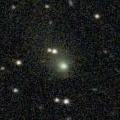
|
It became brighter after the perihelion passage, and it brightened up to 13.4 mag in early 2022 (Jan. 7, Hiroshi Abe). Now it is fading. It has already faded down to 15.8 mag (May 13, Giuseppe Pappa). It will be fainter than 18 mag in summer.
Date(TT) R.A. (2000) Decl. Delta r Elong. m1 Best Time(A, h)
May 28 10 23.91 1 53.7 3.904 4.045 90 16.4 20:48 ( 59, 39)
June 4 10 23.19 1 6.1 4.065 4.089 84 16.5 20:54 ( 66, 32)
|

|
It brightened up to 8.5 mag from autumn to winter in 2021 (Dec. 2, Toshihiko Ikemura, Hirohisa Sato). Now it is fading. It has already faded down to 15.9 mag (May 4, Catalina Sky Survey). It stays observable in good condition for a long time.
Date(TT) R.A. (2000) Decl. Delta r Elong. m1 Best Time(A, h)
May 28 9 50.72 16 8.3 2.539 2.531 78 16.4 20:48 ( 80, 42)
June 4 9 59.89 15 10.2 2.676 2.583 73 16.6 20:54 ( 83, 36)
|

|
It brightened up to 14 mag from 2020 to 2021. Now it is fading slowly. It is observable at 16.5-17 mag in 2022.
Date(TT) R.A. (2000) Decl. Delta r Elong. m1 Best Time(A, h)
May 28 0 19.55 -14 7.4 3.907 3.658 68 16.6 3:06 (291, 5)
June 4 0 25.63 -13 53.4 3.833 3.676 73 16.6 3:02 (294, 9)
|

|
It brightened up to 14 mag in 2021. Now it is fading. It has already faded down to 16.3 mag (May 21, Thomas Lehmann). It is observable at 16-17 mag in 2022.
Date(TT) R.A. (2000) Decl. Delta r Elong. m1 Best Time(A, h)
May 28 0 7.35 6 28.8 5.951 5.551 62 16.6 3:06 (276, 20)
June 4 0 9.47 7 20.5 5.884 5.585 68 16.6 3:02 (279, 25)
|

|
Now it is 16.6 mag (May 8, C. Bell). It was observed at 15 mag in 2021. Now it is fading. It stays observable at 16-17 mag for a while in 2022.
Date(TT) R.A. (2000) Decl. Delta r Elong. m1 Best Time(A, h)
May 28 18 34.99 24 56.4 4.681 5.301 122 16.6 2:15 ( 0, 80)
June 4 18 30.83 26 9.2 4.671 5.322 125 16.7 1:43 ( 0, 81)
|

|
It continued brightening even after the perihelion passage, and it brightened up to 15.2 mag (Feb. 16, Ken-ichi Kadota). Now it is fading. It has already faded down to 17.5 mag (May 1, Catalina Sky Survey). It will be fainter than 18 mag in July.
Date(TT) R.A. (2000) Decl. Delta r Elong. m1 Best Time(A, h)
May 28 11 4.78 8 47.1 2.388 2.714 97 16.7 20:48 ( 55, 51)
June 4 11 12.93 9 19.6 2.514 2.751 92 16.9 20:54 ( 63, 47)
|

|
It brightened up to 14.2 mag in 2021 summer (July 18, 2021, Taras Prystavski). Now it is fading. It has already faded down to 16.2 mag (Jan. 27, SONEAR Observatory, Oliveira). In the Southern Hemisphere, it stays observable in good condition for a long time, although it became extremely low temporarily from March to April. In the Northern Hemisphere, it is not observable until July.
Date(TT) R.A. (2000) Decl. Delta r Elong. m1 Best Time(A, h)
May 28 1 53.69 -26 28.3 5.122 4.685 59 16.8 3:06 (289,-20)
June 4 1 58.73 -26 1.2 5.093 4.723 63 16.8 3:02 (291,-16)
|

|
Now it is 19.3 mag (May 6, iTelescope Observatory, Siding Spring). It is expected to brighten up to 15 mag in autumn, and it will be observable in good condition. But it is fainter than this ephemeris.
Date(TT) R.A. (2000) Decl. Delta r Elong. m1 Best Time(A, h)
May 28 23 44.30 -0 36.2 2.546 2.400 70 17.0 3:06 (286, 20)
June 4 23 55.25 0 23.1 2.447 2.377 74 16.9 3:02 (287, 23)
|

|
It brightened up to 9.5 mag in early summer in 2021 (June 27, Marco Goiato). Now it is fading. It has already faded down to 17.0 mag (May 7, ATLAS Chile). In the Northern Hemisphere, it is not observable until June.
Date(TT) R.A. (2000) Decl. Delta r Elong. m1 Best Time(A, h)
May 28 23 12.62 -32 11.1 3.946 4.081 90 16.9 3:06 (315, 5)
June 4 23 16.61 -32 43.6 3.910 4.141 95 17.0 3:02 (318, 7)
|
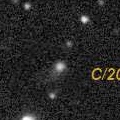
|
Now it is 16.8 mag (May 1, Catalina Sky Survey). It stays observable at 17-18 mag for a long time until 2024.
Date(TT) R.A. (2000) Decl. Delta r Elong. m1 Best Time(A, h)
May 28 13 36.31 3 39.7 8.097 8.822 133 17.0 21:13 ( 0, 59)
June 4 13 32.70 3 57.3 8.188 8.820 125 17.0 20:54 ( 6, 59)
|

|
Appearing in the morning sky. It will be observable at 16.5 mag in good condition from summer to autumn.
Date(TT) R.A. (2000) Decl. Delta r Elong. m1 Best Time(A, h)
May 28 1 1.26 11 21.3 2.669 2.129 48 17.0 3:06 (264, 12)
June 4 1 14.67 12 53.0 2.622 2.137 51 17.0 3:02 (264, 15)
|
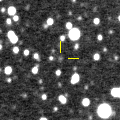
|
Now it is 16.9 mag (May 3, ATLAS Chile). It will brighten up to 13-14 mag from 2024 to 2025.
Date(TT) R.A. (2000) Decl. Delta r Elong. m1 Best Time(A, h)
May 28 7 29.93 -24 30.9 8.263 7.896 65 17.1 20:48 ( 67,-10)
June 4 7 33.86 -24 16.8 8.286 7.859 61 17.0 20:54 ( 71,-16)
|

|
Now it is 16.5 mag (May 3, V. Nevski). Fading slowly. In the Northern Hemisphere, it stays observable in good condition for a long time. In the Southern Hemisphere, it is not observable after this.
Date(TT) R.A. (2000) Decl. Delta r Elong. m1 Best Time(A, h)
May 28 19 0.76 65 47.7 9.176 9.188 87 17.1 2:40 (180, 59)
June 4 18 53.63 66 31.7 9.180 9.200 87 17.2 2:05 (180, 58)
|

|
Now it is 16.6 mag (May 2, Purple Mountain Observatory). It stays 17 mag for a while.
Date(TT) R.A. (2000) Decl. Delta r Elong. m1 Best Time(A, h)
May 28 13 9.19 -7 19.5 3.966 4.709 132 17.2 20:48 ( 1, 48)
June 4 13 8.29 -7 18.3 4.049 4.710 125 17.2 20:54 ( 13, 47)
|
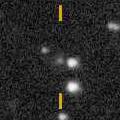
|
Now it is 17.6 mag (May 13, Giuseppe Pappa). It is expected to brighten up to 12.5 mag in winter. It will become unobservable temporarily at 17 mag in July. In the Northern Hemisphere, it will become observable again in October. Then it stays observable in good condition after that. In the Southern Hemisphere, it is not observable at the high light.
Date(TT) R.A. (2000) Decl. Delta r Elong. m1 Best Time(A, h)
May 28 10 27.22 5 30.3 3.469 3.616 90 17.3 20:48 ( 62, 42)
June 4 10 27.00 6 42.1 3.531 3.552 82 17.2 20:54 ( 70, 36)
|

|
Now it is 17.8 mag (Apr. 22, ATLAS Chile). It stays 17 mag for a long time from 2021 to 2022. In the Southern Hemisphere, it stays observable in good condition for a long time. It is not observable in the Northern Hemisphere.
Date(TT) R.A. (2000) Decl. Delta r Elong. m1 Best Time(A, h)
May 28 6 47.57 -40 58.2 5.764 5.524 71 17.4 20:48 ( 57,-26)
June 4 6 50.46 -40 59.6 5.809 5.537 69 17.4 20:54 ( 59,-32)
|

|
Now it is 17.9 mag (May 18, Yasukazu Ikari). It is observable at 17 mag from spring to summer. In the Northern Hemisphere, it becomes low in summer.
Date(TT) R.A. (2000) Decl. Delta r Elong. m1 Best Time(A, h)
May 28 11 19.68 19 45.5 1.730 2.099 96 17.6 20:48 ( 65, 61)
June 4 11 24.78 17 16.2 1.788 2.085 91 17.5 20:54 ( 69, 54)
|

|
Now it is 17.6 mag (May 3, ATLAS Chile). It will brighten up to 16 mag in 2023. In the Southern Hemisphere, it stays observable in good condition for a long time. In the Northern Hemisphere, it will be unobservable soon.
Date(TT) R.A. (2000) Decl. Delta r Elong. m1 Best Time(A, h)
May 28 9 38.95 -16 52.7 3.964 4.047 87 17.6 20:48 ( 53, 18)
June 4 9 41.54 -17 9.4 4.019 4.010 82 17.6 20:54 ( 59, 12)
|
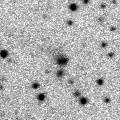
|
Now it is 16.9 mag (May 18, Masayoshi Yoshimi). It started fading before the perihelion passage. It was predicted to stay at 16 mag for a long time. But actually, it will be fainter than 18 mag in autumn. In the Northern Hemisphere, it stays observable in good condition for a long time. In the Southern Hemisphere, it is not observable until 2023.
Date(TT) R.A. (2000) Decl. Delta r Elong. m1 Best Time(A, h)
May 28 0 6.25 80 22.3 4.088 3.765 64 17.6 3:06 (191, 38)
June 4 23 50.76 81 31.4 4.075 3.770 65 17.6 3:02 (189, 39)
|
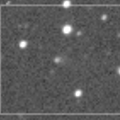
|
It was observed at 17 mag in 2021. It is observable at 17-18 mag also in 2022. It will be observable in June also in the Northern Hemisphere.
Date(TT) R.A. (2000) Decl. Delta r Elong. m1 Best Time(A, h)
May 28 2 0.23 -1 54.8 3.937 3.241 40 17.6 3:06 (267, -8)
June 4 2 7.63 -0 42.7 3.891 3.255 45 17.6 3:02 (268, -4)
|

|
It will brighten up to 16.5 mag in July. In 2022, it stays observable for a long time.
Date(TT) R.A. (2000) Decl. Delta r Elong. m1 Best Time(A, h)
May 28 21 16.54 -14 51.7 0.813 1.495 109 18.0 3:06 (328, 34)
June 4 21 38.79 -12 36.0 0.722 1.435 110 17.7 3:02 (327, 36)
|

|
Now it is 17.8 mag (May 3, Y. Sugiyama). It will be fading after this, and it will be fainter than 18 mag in June.
Date(TT) R.A. (2000) Decl. Delta r Elong. m1 Best Time(A, h)
May 28 11 37.16 10 49.1 2.123 2.564 103 17.7 20:48 ( 47, 58)
June 4 11 42.69 9 57.9 2.236 2.595 98 17.9 20:54 ( 55, 52)
|

|
Now it is 17.2 mag (May 10, Hirohisa Sato). It stays 17-18 mag until June.
Date(TT) R.A. (2000) Decl. Delta r Elong. m1 Best Time(A, h)
May 28 20 27.98 -16 24.5 1.335 2.050 121 17.7 3:06 (341, 36)
June 4 20 3.18 -12 59.1 1.283 2.105 132 17.8 3:02 (355, 42)
|

|
It brightened up to 14.2 mag from summer to autumn in 2021 (Sept. 3, C. S. Morris). Now it is 17.7 mag (May 11, Catalina Sky Survey). Fading slowly. In the Northern Hemisphere, it is observable in good condition. It is not observable in the Southern Hemisphere.
Date(TT) R.A. (2000) Decl. Delta r Elong. m1 Best Time(A, h)
May 28 14 52.83 69 43.7 7.058 7.089 87 17.7 22:27 (180, 55)
June 4 14 38.96 69 21.9 7.137 7.128 85 17.8 21:46 (180, 56)
|

|
Now it is 17.8 mag (Apr. 28, W. Hasubick). It stayed 17.5 mag for a long time in 2021. It will be fading slowly after this. In the Northern Hemisphere, it is observable in good condition. It is not observable in the Southern Hemisphere.
Date(TT) R.A. (2000) Decl. Delta r Elong. m1 Best Time(A, h)
May 28 11 33.02 63 42.0 7.432 7.304 78 17.8 20:48 (160, 58)
June 4 11 33.07 62 32.5 7.509 7.320 75 17.8 20:54 (153, 56)
|

|
Now it is 17.4 mag (May 18, iTelescope Observatory, Siding Spring). It is expected to brighten up to 12-13 mag from 2024 to 2025.
Date(TT) R.A. (2000) Decl. Delta r Elong. m1 Best Time(A, h)
May 28 9 52.75 -22 11.5 7.674 7.784 92 17.8 20:48 ( 47, 16)
June 4 9 52.71 -21 28.5 7.735 7.739 86 17.8 20:54 ( 54, 11)
|

|
It was observed at 16 mag from 2020 to 2021. Now it is fading. It will be fainter than 18 mag in summer.
Date(TT) R.A. (2000) Decl. Delta r Elong. m1 Best Time(A, h)
May 28 22 26.58 15 16.2 6.783 6.727 82 17.9 3:06 (284, 45)
June 4 22 25.60 15 9.3 6.691 6.750 88 17.9 3:02 (289, 50)
|

|
It brightened up to 13.9 mag in 2021 (Aug. 28, 2021, Toshihiko Ikemura, Hirohisa Sato). Now it is fading. It has already faded down to 17.6 mag (May 3, Thomas Lehmann). It will be fainter than 18 mag in June.
Date(TT) R.A. (2000) Decl. Delta r Elong. m1 Best Time(A, h)
May 28 11 16.89 36 39.3 3.324 3.448 88 17.9 20:48 (102, 67)
June 4 11 11.51 35 2.2 3.490 3.500 82 18.1 20:54 (101, 59)
|

|
Now it is 17.3 mag (May 5, ATLAS Chile). Very far object. It stays 18 mag for a long time from 2021 to 2026. In the Southern Hemisphere, it stays observable in good condition for a long time. In the Northern Hemisphere, it is not observable at all.
Date(TT) R.A. (2000) Decl. Delta r Elong. m1 Best Time(A, h)
May 28 7 30.35 -62 40.9 10.616 10.703 92 17.9 20:48 ( 31,-29)
June 4 7 32.43 -62 24.9 10.628 10.693 90 17.9 20:54 ( 33,-32)
|
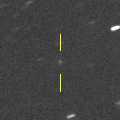
|
Now it is 17.8 mag (Mar. 8, D. Buczynski). The condition is bad in this apparition. It will brighten up to 13 mag in winter. But it is not observable at the high light. Before the perihelion passage, it is observable only until August when it brightens up to 17 mag.
Date(TT) R.A. (2000) Decl. Delta r Elong. m1 Best Time(A, h)
May 28 10 7.19 21 9.8 2.555 2.581 80 18.0 20:48 ( 83, 48)
June 4 10 13.39 20 10.7 2.606 2.543 75 17.9 20:54 ( 87, 41)
|
|
![]()
 (3200) Phaethon
(3200) Phaethon 81P/Wild 2
81P/Wild 2 C/2020 J1 ( SONEAR )
C/2020 J1 ( SONEAR ) 104P/Kowal 2
104P/Kowal 2 C/2020 H6 ( ATLAS )
C/2020 H6 ( ATLAS ) 152P/Helin-Lawrence
152P/Helin-Lawrence 325P/Yang-Gao
325P/Yang-Gao C/2020 M5 ( ATLAS )
C/2020 M5 ( ATLAS ) 67P/Churyumov-Gerasimenko
67P/Churyumov-Gerasimenko 246P/NEAT
246P/NEAT C/2020 F5 ( MASTER )
C/2020 F5 ( MASTER ) C/2020 O2 ( Amaral )
C/2020 O2 ( Amaral ) C/2021 U5 ( Catalina )
C/2021 U5 ( Catalina ) C/2019 F1 ( ATLAS-Africano )
C/2019 F1 ( ATLAS-Africano ) 61P/Shajn-Schaldach
61P/Shajn-Schaldach C/2020 T2 ( Palomar )
C/2020 T2 ( Palomar ) C/2020 F2 ( ATLAS )
C/2020 F2 ( ATLAS ) 44P/Reinmuth 2
44P/Reinmuth 2 C/2021 G2 ( ATLAS )
C/2021 G2 ( ATLAS ) C/2019 O3 ( Palomar )
C/2019 O3 ( Palomar ) 99P/Kowal 1
99P/Kowal 1 C/2022 A2 ( PanSTARRS )
C/2022 A2 ( PanSTARRS ) C/2020 F7 ( Lemmon )
C/2020 F7 ( Lemmon ) 100P/Hartley 1
100P/Hartley 1 C/2021 C5 ( PanSTARRS )
C/2021 C5 ( PanSTARRS ) C/2020 U5 ( PanSTARRS )
C/2020 U5 ( PanSTARRS ) 422P/2021 L1 ( Christensen )
422P/2021 L1 ( Christensen ) 107P/(4015) Wilson-Harrington
107P/(4015) Wilson-Harrington 70P/Kojima
70P/Kojima C/2022 J1 ( Maury-Attard )
C/2022 J1 ( Maury-Attard ) C/2019 K7 ( Smith )
C/2019 K7 ( Smith ) C/2020 P3 ( ATLAS )
C/2020 P3 ( ATLAS ) C/2022 E2 ( ATLAS )
C/2022 E2 ( ATLAS ) C/2019 T3 ( ATLAS )
C/2019 T3 ( ATLAS ) C/2020 PV6 ( PanSTARRS )
C/2020 PV6 ( PanSTARRS ) C/2019 E3 ( ATLAS )
C/2019 E3 ( ATLAS ) 71P/Clark
71P/Clark![]()






















































